By KEVIN WEAKS
 Americans are obsessed with size. You can tell by the proliferation of male enhancement products popping up on TV and online — and by the huge rise in SUV and truck sales.
Americans are obsessed with size. You can tell by the proliferation of male enhancement products popping up on TV and online — and by the huge rise in SUV and truck sales.
According to Bloomberg news, trucks and SUVs have overtaken small and medium-sized car sales to the extent that American factories are closing or retooling to build more-profitable truck-based vehicles. Experts forecast that by 2022 under 35 percent of new car sales will be passenger vehicles and more than 65 percent will be trucks and SUVs.
CNBC reported that by 2022, 84 percent of General Motors vehicles sold in the U.S. will be a truck or SUV. For Fiat Chrysler that ratio will be 97 percent and 90 percent for Ford.
The SUV is here to stay, says Kelly Blue Book.
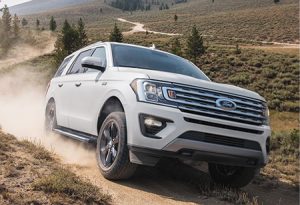
SUVs come in all sizes, but America’s full-size SUVs are a unique automotive genre, notes Motor Trend. “These big, tough, easygoing family hold-alls are well adapted to the relatively cheap gas and wide-open spaces of the United States and Canada. Their pickup truck underpinnings — chassis, suspension, brakes, powertrains, electrical architectures, etc. — are built in high volume and are thus low cost.”
Low cost to the manufacturer, that is. Meanwhile, the average car loan payment just hit a decade high, according to Experian data first reported by Automotive News.
In fourth quarter 2018, the average new vehicle loan (including trucks and SUVs) in the U.S. was $545 per month and $387 per month on average for a used vehicle. The average interest rate was 6.3 percent, also a decade high, according to Edmunds.
One driver of that is the ever-increasing American interest in SUVs, trucks, and crossovers, Edmunds manager of industry analysis Jeremy Acevedo said. And the bigger, apparently, the better. Consumers who go from a sedan to a crossover tend not to return to a smaller car unless there is an economic reason, like gas prices, to do so. “Once you’re in a taller vehicle it becomes hard to switch back,” said Jack R. Nerad of Kelley Blue Book.
2019 FORD EXPEDITION
The Ford Expedition stands as the benchmark full-size, mainstream American SUV. The Expedition debuted as Ford’s answer to the Chevrolet Tahoe and GMC Yukon for the 1997 model year. A large-sized sport utility vehicle built on the F-150 pickup truck platform, the four-door Ford Expedition indirectly succeeded the two-door Bronco.
It also replaced the retired and even larger Ford Excursion after only six model years in the North American Market (2000–2005). The nearest thing Ford now offers is the longer-wheelbase version called the Expedition Max.
However, the Ford Expedition offers plenty to satisfy most large SUV shoppers. It has one of the highest starting prices in the class, and a fully loaded Expedition costs more than some luxury-brand counterparts. Its top competitor includes the Chevrolet Tahoe and its long-wheelbase sibling, the Chevrolet Suburban. Both are a little more affordable than the Ford. Both vehicles offer a comfortable ride, comfortable cabin and a user-friendly infotainment system.
The base Ford Expedition XLT has a window sticker price of $52,130. Standard features include the SYNC connectivity system with a 4.2-inch display, a six-speaker stereo, four USB ports, Bluetooth and satellite radio. The XLT also features a rearview camera, rear parking sensors, Ford’s MyKey, push-button start, cloth seats, a leather-wrapped steering wheel, an auto-dimming rearview mirror, a windshield wiper de-icer, and fog lights.
That’s fairly expensive for an SUV, but prices continue rising with the Ford Expedition Limited ($63,015) and Platinum ($73,365). A fully loaded Expedition can cost close to $85,000, which is more than the starting prices of some luxury rivals.
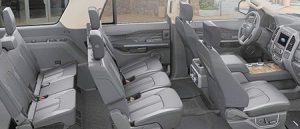
SEATING FOR EIGHT
The Expedition seats eight people, though replacing the split-bench seat with second-row bucket seats lowers seating capacity to seven. Cloth upholstery comes standard. Upgrades include massaging front seats, 10-way power-adjustable front seats, leather upholstery, heated and ventilated front seats, heated and power-folding second-row seats, and a heated steering wheel.
The Expedition has 20.9 cubic feet of space when all three rows are fully upright. That space expands to as much as 63.6 cubic feet with the third row folded down and 104.6 cubic feet with the second and third rows down. That’s impressive even among other full-size SUVs, notes Motor Trend.
The long-wheelbase variant, called the Expedition Max, has even more room. It offers 36 cubic feet of space behind the third row and as much as 121.5 cubic feet of cargo space. Those totals rank among the best in the class. The long-wheelbase body style of the GMC Yukon is one of the few that comes close, offering 121.7 cubic feet of space with both back rows folded down.
NO V8, NO PROBLEM
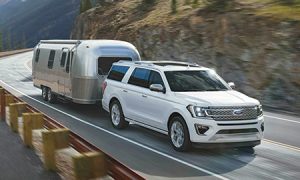
Ford offers a single engine in the Expedition. Most rivals offer V8 engines, but the Expedition instead features a turbocharged 3.5-liter V6 that makes 375 horsepower and 470 pound-feet of torque. In the top-of-the-line Platinum trim, the same engine with premium fuel produces 400 horsepower and 480 pound-feet of torque. A 10-speed automatic transmission is the only one offered. When properly equipped, the full-size 2019 Ford Expedition can tow up to 9,300 pounds.
Despite its lack of a V8 engine option, the Expedition is more than suited for most driving needs. Its turbo V6 makes ample power for towing or effortless passing on the highway. It also provides quicker acceleration than many others in its class, one reviewer said.
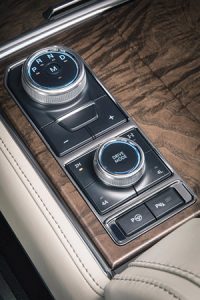
The 2019 Expedition earns an EPA-estimated 17 mpg in the city and 24 mpg on the highway, or 17/22 mpg city/highway with four-wheel drive. Large SUVs tend to earn similar fuel economy estimates. However, the Expedition will still save you about $250 per year over the Chevrolet Suburban and $700 per year over the Toyota Sequoia in fuel costs, estimates USNews.com.
What sets the Expedition apart from rivals like the more truck-like GMC Yukon is its smooth-riding independent rear suspension, and a rotary transmission interface you can actuate with your fingertips, instead of having a traditional column shift lever. These two features alone are the evolutionary steps that catapult the Expedition out of the truck gene pool and into the higher order realm of the personal-use SUV, says Motor Trend. Nearly 55,000 Expeditions were purchased in the U.S. in 2018.
“The 2019 Ford Expedition excels across the board. Its strong engines, classy cabin, tons of features, great predicted reliability rating, and ample cargo space help make it one of our top-ranking large SUVs,” says USNews.com’s auto review.
The website calls the Ford Expedition an excellent large SUV. “It has a handsome cabin with plenty of room for adults in all three rows. Because the Expedition has the best combination of cargo and passenger space, safety and reliability ratings, positive reviews from automotive journalists, and available family-friendly features in its class, we named it our 2019 Best Large SUV for Families.”
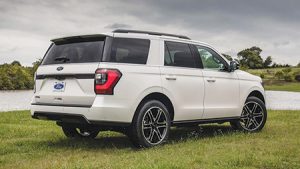
INFOTAINMENT, BLUETOOTH AND MORE
Ford’s standard SYNC connectivity system features four USB ports, Bluetooth, a six-speaker sound system, satellite radio, and a 4.2-inch display. Optional equipment includes the SYNC 3 infotainment system, an eight-inch touch screen, Apple CarPlay, Android Auto, a navigation system, a dual-screen rear-seat entertainment system, a 12-speaker Bang & Olufsen stereo, a Wi-Fi hotspot, wireless device charging, HD Radio, and two more smart-charging USB ports.
Several other safety features are available, including blind spot monitoring with rear cross traffic alert, automatic high beams, lane departure warning, lane keep assist, pedestrian detection, forward collision warning, automatic emergency braking, front parking sensors, parallel park assist, and adaptive cruise control with a stop-and-go function.
FORD EXPEDITION OR LINCOLN NAVIGATOR?
The Lincoln Navigator is the luxury version of the Ford Expedition. Both SUVs were redesigned for the 2018 model year, and each offers a long-wheelbase variant. However, there are some key differences. The Navigator gets a little more horsepower from its twin-turbo V6, and it has a smoother ride, a slightly more upscale cabin, and more standard features than the Expedition. On the other hand, the Expedition has slightly better fuel economy estimates, a higher towing capacity, and a lower price. The 2019 Navigator has a starting price of $73,205, which means you could save about $21,000 if you go with the Ford. However, a base Expedition won’t be as well-equipped as a base Navigator.
Prior to 2009, the Ford Expedition was assembled at the Michigan Assembly Plant in Wayne, Michigan (previously home to the Ford Bronco). After 2009, the Ford Expedition was moved to the UAW-staffed Kentucky Truck Plant in Louisville, Kentucky, where the Lincoln Navigator is built.
Contact Kevin Weaks at kweaks@labortribune.com.

